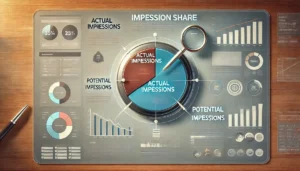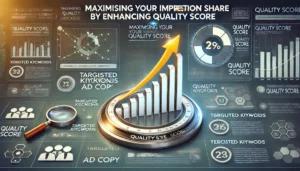Impression Share (IS): Strategies for Success

Maximising your Impression Share (IS) is key to making your ads more visible and reaching a larger audience. This article will guide you through several strategies to help you improve your IS. By understanding what IS is and learning how to optimise your budget, refine targeting, enhance quality scores, analyse competitors, and adjust bids, you can boost your ad performance significantly.
Key Takeaways
- Understand the importance of Impression Share (IS) for ad visibility.
- Optimise your budget to ensure high-performing campaigns receive adequate funding.
- Refine your targeting strategies to reach the right audience at the right time.
- Enhance your Quality Score by improving ad relevance, landing page experience, and expected click-through rate (CTR).
- Regularly analyse competitors and adapt successful tactics to stay ahead.
Understanding Impression Share
Definition and Importance
Impression share is a key metric in online advertising that measures how often your ads are shown to your target audience compared to how often they could have been shown. It is calculated by dividing the number of impressions your ads received by the estimated number of impressions they were eligible to receive. Understanding your IS helps you gauge the visibility of your ads and identify missed opportunities for exposure.
Factors Affecting Impression Share
Several factors can influence your impression share, including:
- Budget: Limited budget can restrict the number of times your ads are shown.
- Ad Quality: High-quality ads are more likely to be displayed.
- Competition: The number of competitors and their strategies can impact your share.
- Targeting Settings: Specific targeting can limit or expand your audience reach.
Types of Impression Share Metrics
There are different types of impression share metrics to consider:
- Search Impression Share: The percentage of impressions your ads receive on search networks.
- Display Impression Share: The percentage of impressions your ads receive on display networks.
- Absolute Top Impression Share: The percentage of impressions your ads receive in the very top position.
- Top Impression Share: The percentage of impressions your ads receive in the top positions above the organic search results.
By understanding and optimising these metrics, you can improve your ad visibility and overall campaign performance.
Maximising Your Impression Share (IS): Optimising Budget Allocation
Identifying High-Performing Campaigns
To make the most of your budget, start by identifying which campaigns are delivering the best results. Look at metrics like conversion rate, click-through rate (CTR), and return on ad spend (ROAS). Focus your budget on these high-performing campaigns to maximise your IS.
Balancing Budget Across Campaigns (Maximising Your Impression Share)
Once you’ve identified your top campaigns, it’s important to balance your budget across all your campaigns. This ensures that you’re not putting all your eggs in one basket. Use a mix of aggressive bidding for high-priority campaigns and more conservative bids for others. This balanced approach helps you maintain a strong impression share without overspending.
Monitoring and Adjusting Budget
Regularly monitor your budget allocation to ensure it’s still aligned with your goals. Market conditions and campaign performance can change, so be prepared to adjust your budget as needed. Use automated tools to help you make real-time adjustments, ensuring your budget is always optimised for the best possible IS.
Consistent monitoring and timely adjustments are key to maintaining an effective budget allocation strategy.
Maximising Your Impression Share (IS): Refining Targeting Strategies
Location Targeting
To maximise your Google ads PPC campaigns, focus on location targeting. By narrowing down your audience to specific geographic areas, you can ensure your ads reach the most relevant users. For instance, a London PPC agency might target ads specifically to users in London to increase local engagement. Adjusting your location settings can significantly impact your impression share.
Device Targeting (Maximising Your Impression Share)
Device targeting allows you to tailor your ads based on the devices your audience uses. Whether it’s mobile, desktop, or tablet, understanding which device performs best can help you allocate your budget more effectively. For example, if mobile users are more likely to convert, you might increase bids for mobile devices. This strategy is crucial for any PPC management plan.
Audience Targeting
Audience targeting involves reaching users based on their interests, behaviours, and demographics. By leveraging advanced targeting options provided by Google Adwords PPC, you can ensure your ads are shown to the most relevant users. This targeted approach can increase the chances of your ads being clicked and improve your impression share. Google advertising agencies often use this method to refine their campaigns and achieve better results.
Remember, expanding your targeting options isn’t just about casting a wider net; it’s about casting the right net. Combine these strategies, analyse performance, and iterate to optimise your impression share and connect with potential customers effectively.
Maximising Your Impression Share (IS): Enhancing Quality Score
Improving Ad Relevance
To boost your Quality Score, ensure your ads are highly relevant to the keywords you’re targeting. This means your ad copy should closely match the search intent of users. Crafting compelling and precise ad copy can significantly improve your ad relevance. Avoid using broad match keywords that are too generic; instead, opt for specific phrases that align with your product or service.
Optimising Landing Page Experience (Maximising Your Impression Share)
Your landing page plays a crucial role in determining your Quality Score. Make sure the content on your landing page is directly related to your ad copy and keywords. A seamless user experience, with fast load times and easy navigation, can greatly enhance your Quality Score. Consider using clear calls-to-action and ensuring your landing page is mobile-friendly.
Boosting Expected Click-Through Rate (CTR)
Expected CTR is a prediction of how often your ad will be clicked when shown. To improve this metric, focus on creating engaging ad headlines and descriptions that attract clicks. Use ad extensions to provide additional information and make your ad more appealing. Regularly test different ad variations to see which ones perform best and adjust accordingly.
Consistently monitoring and refining these elements will help you achieve a higher Quality Score, leading to better ad placements and increased impression share.
Maximising Your Impression Share (IS): Conducting Competitor Analysis
Identifying Competitors with Higher IS
To get ahead, you need to know who you’re up against. Start by identifying competitors with a higher Impression Share (IS). Use tools like Google Ads Auction Insights to see who’s outperforming you. Knowing your competitors helps you understand the landscape better. This step is crucial for a thorough PPC audit.
Analysing Competitor Strategies (Maximising Your Impression Share)
Once you know who your competitors are, dig into their strategies. Look at their ad copy, keywords, and landing pages. Use SWOT analysis to identify their strengths, weaknesses, opportunities, and threats. For example, if a competitor has a strong social media presence, you might focus on improving your own engagement on platforms like Instagram.
Adapting Successful Tactics
After analysing, adapt the successful tactics of your competitors. If they dominate IS for certain keywords, consider investing in similar keywords or ad formats. For instance, if a competitor excels with video ads, you might allocate resources to create compelling video content. This way, you can level the playing field and even gain an edge.
Regular competitor analysis is like a chess game; knowing your opponent’s moves helps you plan your own. Keep adapting and stay ahead.
Maximising Your Impression Share (IS): Implementing Bid Adjustments
Raising Bids for Top-Performing Keywords
To maximise your impression share, focus on your top-performing keywords. Increase your bids for these keywords to ensure they appear in higher ad positions. This can significantly boost your visibility and click-through rates. Regularly conduct a Google ads audit to identify which keywords are driving the most value.
Using Automated Bidding Strategies (Maximising Your Impression Share)
Automated bidding strategies can save you time and optimise your bids in real-time. Tools like Google Ads’ Smart Bidding use machine learning to adjust your bids based on the likelihood of a click or conversion. This ensures your budget is spent efficiently, maximising your IS without constant manual adjustments.
Monitoring Bid Performance
Keep a close eye on your bid performance. Use performance data to make informed decisions about where to increase or decrease bids. Regular monitoring helps you stay competitive and adapt to market changes quickly.
Consistent bid adjustments based on performance data can lead to sustained growth in your impression share. Always be ready to tweak your strategy as needed.
Maximising Your Impression Share (IS): Continuous Optimisation for Long-Term Growth
Regular Performance Analysis
To keep your impression share growing, you need to regularly check how your ads are doing. Look at key metrics like click-through rates (CTR), conversion rates, and cost-per-click (CPC). Regular analysis helps you spot trends and areas for improvement. Use this data to make informed decisions and tweak your strategies.
Adapting to Market Changes (Maximising Your Impression Share)
The market is always changing, and so should your strategies. Keep an eye on industry trends, competitor moves, and changes in customer behavior. Adapt your campaigns to stay relevant and effective. This might mean updating your ad copy, changing your targeting, or adjusting your bids.
Leveraging Advanced Tools and Techniques
Use advanced tools and techniques to get the most out of your campaigns. Automated bidding strategies, machine learning algorithms, and advanced analytics can help you optimise your ads more efficiently. These tools can save you time and improve your results.
Continuous optimisation is key to long-term success. By regularly analysing performance, adapting to market changes, and leveraging advanced tools, you can keep your impression share growing and stay ahead of the competition.
Conclusion
In conclusion, boosting your Impression Share (IS) is a continuous journey that requires regular monitoring and fine-tuning. By increasing your budget, refining your targeting, improving your Quality Score, analysing competitors, and adjusting bids, you can significantly enhance your ad visibility. Remember, each campaign is unique, so it’s essential to keep experimenting and adapting your strategies. Stay proactive, keep learning, and you’ll see your IS grow over time.
Frequently Asked Questions
What is Impression Share (IS)?
Impression Share (IS) is a metric that shows the percentage of impressions your ads receive compared to the total number of impressions they could get. It helps you understand how often your ads are being shown.
Why is IS important?
Impression Share is important because it shows how well your ads are performing in terms of visibility. A higher IS means your ads are being shown more often, which can lead to more clicks and potential customers.
What factors affect Impression Share?
Several factors can affect your Impression Share, including your budget, bids, ad quality, and targeting settings. Optimising these factors can help improve your IS.
How can I improve my IS?
To improve your Impression Share, you can increase your budget, refine your targeting, enhance your ad quality, analyse your competitors, and adjust your bids for top-performing keywords.
What are the types of Impression Share metrics?
There are different types of Impression Share metrics, including Search Impression Share, Display Impression Share, and Video Impression Share. Each one measures IS for different types of ad campaigns.
How often should I monitor my IS?
It’s a good idea to regularly monitor your Impression Share, at least once a week. This helps you stay on top of your ad performance and make necessary adjustments to improve your IS.
Author
Search Blog
Free PPC Audit
Subscribe to our Newsletter
The Voices of Our Success: Your Words, Our Pride
Don't just take our word for it. With over 100+ five-star reviews, we let our work-and our satisfied clients-speak for us.
"We have been working with PPC Geeks for around 6 months and have found Mark and the team to be very impressive. Having worked with a few companies in this and similar sectors, I rate PPC Geeks as the strongest I have come across. They have taken time to understand our business, our market and competitors and supported us to devise a strategy to generate business. I value the expertise Mark and his team provide and trust them to make the best recommendations for the long-term."
~ Just Go, Alasdair Anderson




